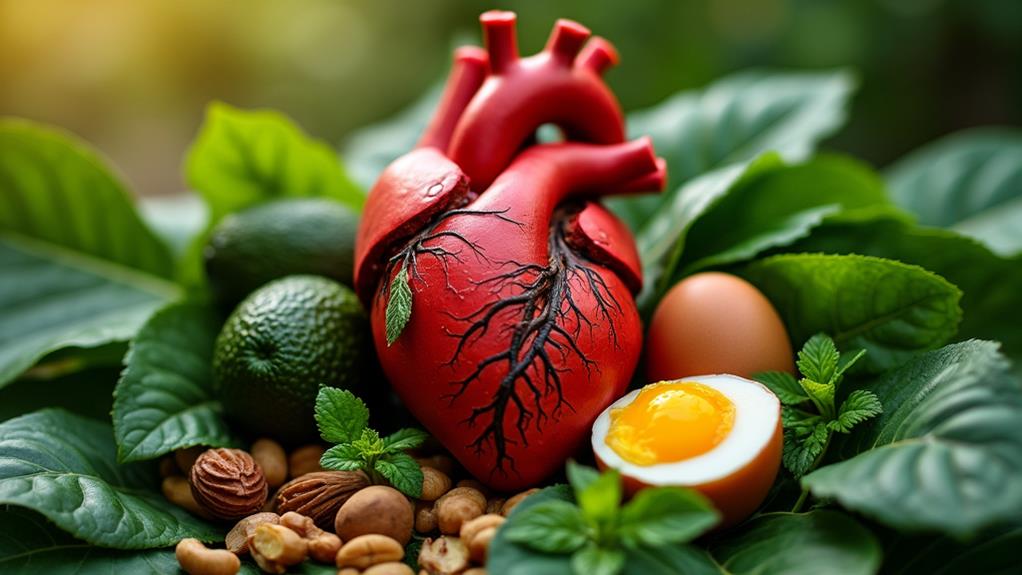







Age and gender play significant roles in determining your vitamin and mineral needs. For instance, women require more iron during their reproductive years, needing 18 mg daily compared to 8 mg for men. After age 50, these iron needs equalize. Calcium requirements also shift; women over 51 need 1,200 mg daily, while men need 1,000 mg until age 71. As you age, absorption rates for vitamins like B12 and D may decline, increasing your need for supplements. Understanding these differences helps you tailor your diet effectively. There's much more to explore about how these factors affect your nutrition.
Key Takeaways
- Men generally require higher caloric and protein intake due to greater muscle mass compared to women.
- Women need more iron during reproductive years, while both genders require equal amounts after age 50.
- Older adults need increased calcium and vitamin D to support bone health, especially women post-menopause.
- Nutrient absorption, particularly vitamin B12, decreases with age, necessitating potential supplementation for older adults.
- Dietary preferences differ by gender, with women leaning towards plant-based foods and men favoring meat, impacting nutrient intake.
Nutritional Differences by Gender
When it comes to nutritional needs, men and women differ considerably due to factors like muscle mass and reproductive health. Men typically require more calories, as higher muscle mass drives their energy needs. Taller and heavier individuals often see their caloric requirements increase further. Women, especially during pregnancy and lactation, may benefit from taking supplements like the Nature Made Prenatal Multivitamin to address their unique nutritional requirements.
When looking at specific nutrients, women need more iron than men, especially during their reproductive years. The recommended intake for women is 18 mg per day, compared to just 8 mg for men. Additionally, Vitamin A needs vary: men aged 19-50 should aim for 900 mcg daily, while women in the same age group only need 700 mcg.
Magnesium intake also showcases gender differences, with men requiring about 400 mg and women needing 310 mg daily if they're aged 19-30. Calcium is especially essential for women to help prevent osteoporosis. For women aged 51 and older, the recommended dietary allowance (RDA) rises to 1,200 mg, while men aged 19-70 require 1,000 mg.
Understanding these nutritional differences can help you tailor your diet to meet your specific needs, ensuring ideal health throughout your life.
Key Nutrients for Men and Women
Understanding key nutrients is essential for both men and women, as their specific dietary needs often vary greatly. For instance, men typically require a higher protein intake—about 56 grams per day—compared to 46 grams for women. This increased protein is important for muscle growth and repair. Additionally, women have unique nutritional needs during pregnancy, making it important to focus on the significance of vitamin B9 to support fetal health. Zinc is another essential nutrient; men need 11 mg daily to support testosterone production, while women require about 8 mg.
Iron demands also differ markedly between genders. Women need 18 mg of iron daily during their reproductive years due to menstrual blood loss, whereas men only need 8 mg. Folate plays a critical role for women, especially during pregnancy, with an RDA of 600 mcg compared to 400 mcg for men.
Muscle Mass and Metabolism
Muscle Mass and Metabolism
Men and women's differing nutritional needs considerably impact muscle mass and metabolism. Generally, males have higher muscle mass, leading to a greater metabolic rate and increased caloric needs. This means you might require more energy-rich foods and protein to support muscle maintenance and growth. If you're a man, you likely burn more calories at rest due to that extra muscle, so paying attention to your dietary intake is essential. Multivitamins can play a supportive role in maintaining energy levels, especially if they contain essential nutrients like B vitamins for energy production. As you age, muscle mass tends to decline, which can reduce your metabolic rate. This shift necessitates dietary adjustments to prevent weight gain and maintain muscle health. If you experience a loss in muscle mass, you may need to reevaluate your caloric needs and protein requirements. For older adults with higher muscle mass, nutritional needs might exceed national recommendations because they require more protein and calories to preserve that muscle.
Additionally, hormonal changes, especially in women after menopause, can affect muscle mass and metabolism. This can lead to different dietary needs compared to younger individuals. Understanding these factors can help you make informed choices about your nutrition, ensuring you meet your unique requirements for peak health.
Age-Related Nutritional Changes
As you age, your nutritional needs often shift considerably, reflecting changes in metabolic processes and nutrient absorption. For older adults, the absorption of certain vitamins, such as vitamin B12, decreases, making it vital to either increase dietary intake or consider supplementation. In the age ranges of 51 to 70, the recommended dietary allowance (RDA) for vitamin D is 15 mcg (600 IU), but it rises to 20 mcg (800 IU) for those aged 71 and older.
Calcium requirements also change, especially for women post-menopause, who should aim for 1,200 mg daily. Men, too, should increase their intake to 1,200 mg starting at age 71. While older adults typically have lower calorie needs, their nutrient requirements remain the same or even increase, underscoring the importance of consuming nutrient-dense foods.
Additionally, after age 50, iron needs equalize between genders, but women aged 51 and older must guarantee adequate intake to prevent deficiencies, particularly if they've experienced significant blood loss. Prioritizing these nutrients can help maintain health and well-being as you age.
Health Goals and Dietary Needs
Steering health goals and dietary needs becomes increasingly important as you age, with specific requirements influenced by both age and gender. For women, increased iron intake is essential during reproductive years, while men need more protein to maintain muscle mass. After age 50, iron needs level out, but women should boost calcium intake post-menopause at age 51. Similarly, men's calcium needs rise at age 71.
As you reach your 50s, it's important to focus on the right nutrients. Males aged 51 and older require 900 mcg of Vitamin A, while females need 700 mcg. Protein intake becomes essential for preserving muscle mass, especially for those aged 71 and above. Incorporate healthy foods like seafood, dairy, beans, and lentils into your diet to meet these protein needs.
Don't forget about Vitamin B12; its absorption decreases with age, necessitating dietary adjustments or supplements. This is particularly significant if you're taking certain medications. Tailoring your dietary needs to support your health goals can help prevent health conditions and guarantee you're meeting your nutritional requirements as you age.
Micronutrients for Different Ages
Understanding micronutrient needs is vital as you navigate different life stages. Your iron requirements differ markedly based on gender and age. For example, women aged 19-50 need 18 mg of iron daily, while men only require 8 mg. This distinction is important, especially during reproductive years.
Calcium intake also changes with age. Women post-menopause need 1,200 mg daily, while men require 1,000 mg until age 71, after which their needs rise to 1,200 mg. Both genders aged 51-70 should aim for 15 mcg (600 IU) of vitamin D, increasing to 20 mcg (800 IU) at 71 and older.
Regarding vitamin A, men need 900 mcg daily, whereas women require 700 mcg. Finally, magnesium requirements vary, too; men over 51 need 420 mg, while women need 320 mg daily.
Impact of Hormones on Nutrition
Hormones play an essential role in shaping nutritional needs throughout various life stages, particularly for women and men. In women, hormonal fluctuations during the menstrual cycle greatly affect iron requirements, with increased needs during menstruation due to blood loss. Pregnancy and lactation further elevate women's needs for folate, iodine, and iron to support fetal development and maternal health.
For post-menopausal women, estrogen's influence on calcium metabolism leads to higher calcium needs to prevent osteoporosis. Men, on the other hand, experience increased protein requirements due to testosterone levels, which affect muscle mass and metabolic rate.
As you age, hormonal changes can impact nutrient absorption. For instance, decreased stomach acid production may reduce vitamin B12 absorption in older adults, complicating their nutritional needs. Additionally, both men and women might face alterations in nutrient requirements due to declining hormone levels, making it essential to monitor and adjust dietary intake accordingly. Understanding these hormonal impacts allows you to better meet your nutritional needs as you navigate different life stages.
Dietary Sources of Essential Nutrients
Essential nutrients are essential for maintaining health across all life stages, and knowing where to find them can greatly impact your well-being. For calcium, which supports bone health, aim for 1,200 mg daily if you're aged 51 or older. Excellent dietary sources include dairy products, fortified foods, and leafy greens.
Vitamin D also becomes increasingly significant as you age, with a requirement of 20 mcg (800 IU) daily after age 71. Fatty fish, fortified milk, and cereals are key dietary sources to help you meet this need.
Folate is essential for both men and women, and you should aim for 400 mcg DFE daily. Rich sources of folate include dark leafy greens, beans, peas, and citrus fruits, which can easily be incorporated into your meals.
Lastly, magnesium plays an important role in numerous bodily functions. Men aged 51 and older need 420 mg, while women require 320 mg daily. Nuts, whole grains, and leafy greens serve as primary dietary sources of magnesium. By including these foods in your diet, you can guarantee you're meeting your essential nutrient requirements effectively.
Food Preferences and Choices
Your food preferences and choices play a significant role in meeting your nutritional needs. Research shows that women often prefer whole grains, cereals, and vegetables, while men lean towards meat, associating it with masculinity. These dietary patterns can influence the nutrients you need. Women are more likely to adopt vegan or vegetarian diets, driven by health and environmental concerns, which can lead to healthier eating behaviors. They tend to avoid high-fat foods and incorporate more fiber-rich options into their meals.
In contrast, men generally have a more favorable view of meat consumption, resulting in higher intakes of animal protein. This difference in food choices means that men may fulfill their protein needs effectively but might overlook other essential nutrients found in plant-based foods. Additionally, women often limit gluten, red meat, and preservatives more than men, showcasing a distinct approach to dietary choices.
Understanding these differing preferences helps you recognize how your dietary pattern impacts your overall health. By being mindful of your food choices, you can better address your different nutritional needs and guarantee you get the essential nutrients required for peak well-being.
Tailoring Nutrition for Health Conditions
Tailoring nutrition to address specific health conditions is fundamental for maintaining ideal well-being. Understanding how age and gender influence nutrient requirements enables you to make informed dietary choices. For instance, women in their reproductive years should aim for an iron intake of 18 mg daily, while men need only 8 mg, reflecting menstrual blood loss.
As you age, calcium requirements also shift. Women post-menopause need 1,200 mg daily to support bone health, similar to men starting at age 71. Additionally, older adults often experience reduced absorption of Vitamin B12, so it's important to include fortified foods or supplements in your diet.
Protein intake is another key consideration. To prevent muscle mass loss, older adults should prioritize higher protein consumption, with men requiring about 56 grams and women 46 grams daily. These dietary recommendations are essential for maintaining strength and overall health.
Conclusion
In a world where every bite can either fuel your vitality or drain your energy, understanding how age and gender impact your vitamin and mineral needs is essential. You're not just what you eat; you're how well you nourish your unique body. Tailoring your diet to meet these fundamental requirements isn't just significant; it's a game-changer for your health. Embrace these insights, and you'll release a vibrant, unstoppable version of yourself that's ready to conquer anything!







